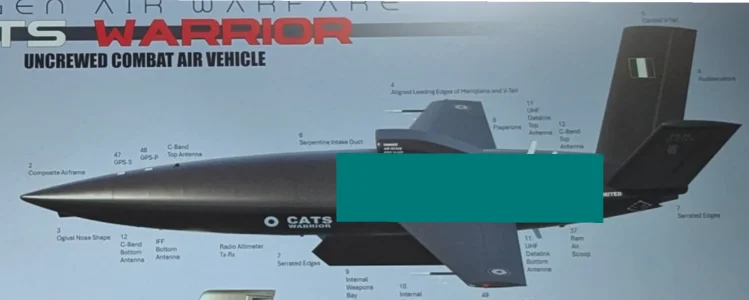- Joined
- Jul 1, 2024
- Messages
- 4,718
- Likes
- 24,760
Add ISA plus 30 in case of Flat Rating values in the graph I've enclosed. For instance check values for 91 KN on the y axis & see where it meets the line for 30 .But Kaveri is flat rated so above graph doesn't apply to it I guess. Kaveri 's flat rated thrust most probably include the values around ISA. So it would give constant thrust around ISA+-20/30°, after a certain high temp even Kaveri's performance might deteriorate.
View attachment 25319
We tested it in winter of Moscow, if it's peaking at 48/73 there at cold temp, it might be very difficult for it to achieve 60/ 90 there.Add ISA plus 30 in case of Flat Rating values in the graph I've enclosed. For instance check values for 91 KN on the y axis & see where it meets the line for 30 .
We're talking about two different values here. That 60/90 corresponds to 54/81 not 48/73.We tested it in winter of Moscow, if it's peaking at 48/73 there at cold temp, it might be very difficult for it to achieve 60/ 90 there.
But it's the same engine. Russian conditions might be colder than ISA. So do you mean to say that 48/73 performance in Russia will translate 44/68 in India ?We're talking about two different values here. That 60/90 corresponds to 54/81 not 48/73.
We are assuming that "Indian conditions" are isa+30.Add ISA plus 30 in case of Flat Rating values in the graph I've enclosed. For instance check values for 91 KN on the y axis & see where it meets the line for 30 .
No , you're confusing flat ratings with performance beyond a certain parameter .But it's the same engine. Russian conditions might be colder than ISA. So do you mean to say that 48/73 performance in Russia will translate 44/68 in India ?
We are assuming that "Indian conditions" are isa+30.
I should've addressed it here . Didn't pay much attention to it .But Kaveri is flat rated so above graph doesn't apply to it I guess. Kaveri 's flat rated thrust most probably include the values around ISA. So it would give constant thrust around ISA+-20/30°, after a certain high temp even Kaveri's performance might deteriorate.
View attachment 25319
Bruh...69% of my messages are just memes and shitpostsThey post on so many topics
Well, there are two three points that needs to be addressed before we can do something like thisAlso can anyone tell me why a CATS warrior can't be modified to become an unmanned FTB for kaveri ?

There's is absolutely no doubt about the novelty of this idea; a unmanned drone is definitely going to perhaps even be a better FTB than a manned one...but sadly not CATS; it's too small. It's like asking whether it's a good idea to add a 105mm gun in a lighter platform. Yes definitely it is, but that lighter platform can't be a jeep.BTW it's a very novel suggestion. I wish I could've thought of it. Feeling jealous.

Thanks for the detailed reply, much appreciated. My thinking is on the lines of not having the human risk factor while testing an unknown new engine. Perhaps a bigger CATS warrior with 2 engine bays will help. I am thinking designing such a thing from scratch purely as a test bed would be easier than modifying existing Boeing or airbus who already have miles of cabling & piping inside ?Bruh...69% of my messages are just memes and shitposts
Well, there are two three points that needs to be addressed before we can do something like this
• Redundancy
Typically, the whole idea of a FTB is a plane that can do everything on its own and have an extra engine duct taped to it. So, it takes off with its own power, attains a stable altitude, slowly starts the "test article", increases till maximum revs, all while asymmetrically lowering its own thrust so that there isn't any turning moment due to this weirdly placed engine, collects data, turns the engine off, lands with its own power. With time and confidence, the time interval in which the test engine is run is increased, ultimately running from before take-off to after landing. So, the summary of all this Satyanarayana Katha is that the only job of a test engine in a typical FTB is feeding gigs worth of data every minute; that's it.
But in case of a single engine UAV like CATS, the same engine that needs to be tested is also the one responsible for every single thing on the FTB from propulsion to electricity generation. This can seriously mess up your redundancy.
• Data Analysis
More or less an extension of the previous point. Let's say your Boeing 737 based test bed is testing Kaveri in a pod attachment and suddenly there's a flameout or even a near catastrophic failure. So let it be! The plane would simple land unscathed, the whole pod would be removed and shipped to DRDO or HAL and they'll have a thorough investigation on the cause.
But let's say this same happens on a small, single engine CATS with Kaveri test engine. Now you'll first need Belgian Malinois to search God knows how many square kilometers of area to find all the bits and pieces of the engine and then do analysis of whatever you find.
• The good ol' SWaP that I keep bringing
Here's the rough size of Kaveri compared to that of CATS
View attachment 25321
The proportion is huge also you'll be now on very limited fuel because on one hand you're consumption is going up and on other your internal volume is going down.
• Stability
Take the example of the famous Pratt & Whitney FTB. It's 150 tonnes Boeing 747 so it's bit tough for a single test engine to unstabilize it. And even if it does then also you have four onboard engines producing 800kN of thrust that can balance it out. Now consider CATS; a 2t MTOW plane where 1t is just Kaveri with dry thrust of 50kN...a TWR of whopping 2.5; basically a rocket.
There's is absolutely no doubt about the novelty of this idea; a unmanned drone is definitely going to perhaps even be a better FTB than a manned one...but sadly not CATS; it's too small. It's like asking whether it's a good idea to add a 105mm gun in a lighter platform. Yes definitely it is, but that lighter platform can't be a jeep.
You'll need a big, multi-engined UAV like this maybe
View attachment 25322
But then the age-old question arises, viability.
How viable it is to make just one-piece UAV from scratch when you can acquire a retired airlines and modify it?
You can buy an old airliner from 10-50 million dollars, could be more for more bigger and less older ones.Thanks for the detailed reply, much appreciated. My thinking is on the lines of not having the human risk factor while testing an unknown new engine. Perhaps a bigger CATS warrior with 2 engine bays will help. I am thinking designing such a thing from scratch purely as a test bed would be easier than modifying existing Boeing or airbus who already have miles of cabling & piping inside ?
The test facility will be ready far earlier than the 130kN engine. Or is it also made to continue R&D work on Kaveri ?
Dilli abhi dur Hai. Until india acquires FTBs and builds HATF , we can't still say that India is serious in developing domestic engine facility.This is for continuous r&d work for kaveri and all it's derivatives.
This simply shows we are finally getting serious about developing a domestic engine family.
Dilli abhi dur Hai. Until india acquires FTBs and builds HATF , we can't still say that India is serious in developing domestic engine facility.
Good investment imo and it's absolutely critical that we do this on a war footing.The Director GTRE Dr S.V. Ramana Murthy is projecting an investment cost of 2.5 billion USD to develop the 85 KN Kaveri Derivative Engine (KED) which includes cost of setting up infrastructure namely an HATF , FTB among other facilities to test & mfg components for it.

